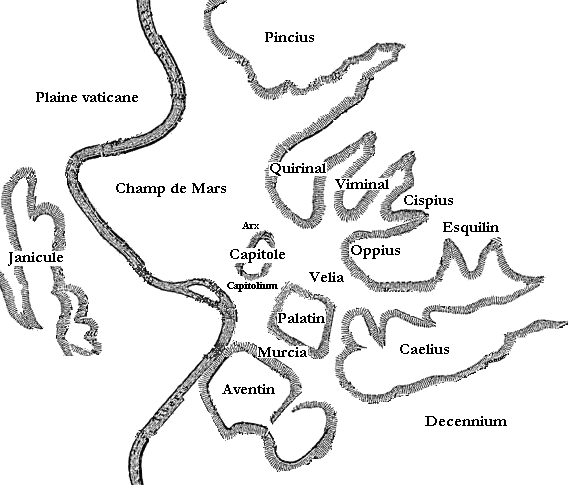Oppian Hill on:
[Wikipedia]
[Google]
[Amazon]
 The Oppian Hill (
The Oppian Hill (
Platner and Ashby
{{coord, 41.893413, N, 12.496541, E, type:mountain_scale:100000_source:ruwiki, display=title Septimontium Rome R. I Monti
 The Oppian Hill (
The Oppian Hill (Latin
Latin (, or , ) is a classical language belonging to the Italic languages, Italic branch of the Indo-European languages. Latin was originally a dialect spoken in the lower Tiber area (then known as Latium) around present-day Rome, but through ...
, ''Oppius Mons''; it, Colle Oppio) is the southern spur of the Esquiline Hill, one of the Seven hills of Rome, Italy. It is separated from the Cispius on the north by the valley of the Suburra, and from the Caelian Hill on the south by the valley of the Colosseum
The Colosseum ( ; it, Colosseo ) is an oval amphitheatre in the centre of the city of Rome, Italy, just east of the Roman Forum. It is the largest ancient amphitheatre ever built, and is still the largest standing amphitheatre in the world ...
. The Oppius and the Cispius together form the Esquiline plateau
In geology and physical geography, a plateau (; ; ), also called a high plain or a tableland, is an area of a highland consisting of flat terrain that is raised sharply above the surrounding area on at least one side. Often one or more sides ...
just inside the line of the Servian Wall.
In the divisions of the Septimontium
The Septimontium was a proto-urban festival celebrated in ancient Rome by ''montani'', residents of the seven ''(sept-)'' communities associated with the hills or peaks of Rome ''(montes)'': Oppius, Palatium, Velia, Fagutal, Cermalus, Caelius, ...
(seven hills) Fagutal appears as an independent locality, which implies that originally "Oppius" was strictly applied to this spur except the western end. The northern tip of this western end was also called Carinae
''Carinae'' was an area of ancient Rome. It was one of its most exclusive neighborhoods, where many of the senatorial class lived.
Florus described the ''Carinae'' as the "''most celebrated part of the city''" (''celeberrima pars urbis'').
Des ...
, which extended between the Velian Hill and the Clivus Pullius, looked out to the southwest (across the swamps of the Palus Ceroliae towards the Aventine), incorporated the Fagutal and was one of ancient Rome's most exclusive neighborhoods.
At least for religious purposes the name Oppius continued in use to the end of the Roman Republic
The Roman Republic ( la, Res publica Romana ) was a form of government of Rome and the era of the classical Roman civilization when it was run through public representation of the Roman people. Beginning with the overthrow of the Roman Ki ...
; no later instance has been found. According to Varro, its name derives from Oppius, a citizen of Tusculum
Tusculum is a ruined Classical Rome, Roman city in the Alban Hills, in the Latium region of Italy. Tusculum was most famous in Roman times for the many great and luxurious patrician country villas sited close to the city, yet a comfortable dist ...
who came to the Romans' assistance during Tullus Hostilius
Tullus Hostilius (r. 672–640 BC) was the legendary third king of Rome. He succeeded Numa Pompilius and was succeeded by Ancus Marcius. Unlike his predecessor, Tullus was known as a warlike king who according to the Roman Historian Livy, bel ...
's siege of Veii
Veii (also Veius; it, Veio) was an important ancient Etruscan civilization, Etruscan city situated on the southern limits of Etruria and north-northwest of Rome, Italy. It now lies in Isola Farnese, in the Comuni of the Province of Rome, comune ...
. However, the word's true etymology is obscure. It may possibly be that of a clan that lived in this area, a gens name of plebeian status. Detlefsen's conjecture that Oppius is derived from Oppidus was revived by Pinza, who regards the name as comparatively late.
The Oppian Hill Park ( it, Parco del Colle Oppio) covers about eleven hectares. It was developed in 1871, as part of the urban reorganization that followed the establishment of Rome as the capital of Italy. From that time the area was used as a public garden. But it was during the fascist era when work was carried out to give the park its present appearance. This was planned in 1928 under the guidance of the architect Raffaele De Vico, and completed in 1936. Work included the fountains, statues and marble sculpture
Marble has been the preferred material for stone monumental sculpture since ancient times, with several advantages over its more common geological "parent" limestone, in particular the ability to absorb light a small distance into the surface be ...
s that decorate the park today. A central avenue leads down the hill to the Colosseum, providing an attractive view.
The Oppian Hill Park is considered to be an archaeological park. Much of the Domus Aurea (Golden House of Nero
Nero Claudius Caesar Augustus Germanicus ( ; born Lucius Domitius Ahenobarbus; 15 December AD 37 – 9 June AD 68), was the fifth Roman emperor and final emperor of the Julio-Claudian dynasty, reigning from AD 54 un ...
) lies under it, and it also contains the ruins of the Baths of Trajan and the earlier Baths of Titus.
See also
References
External links
Platner and Ashby
{{coord, 41.893413, N, 12.496541, E, type:mountain_scale:100000_source:ruwiki, display=title Septimontium Rome R. I Monti